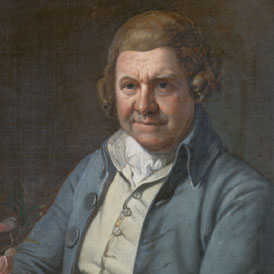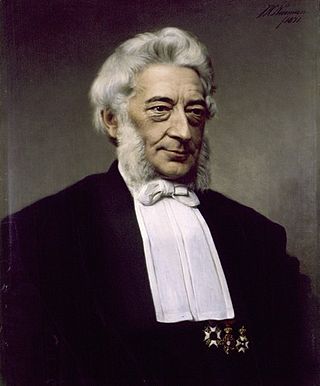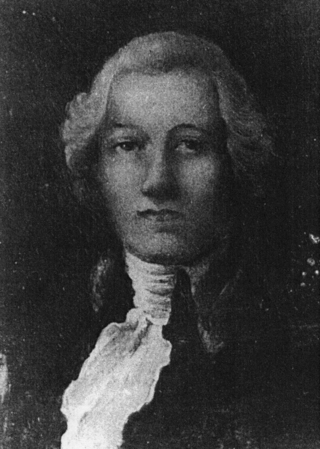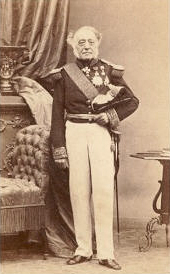Related Research Articles

Urbain Jean Joseph Le Verrier FRS (FOR) HFRSE was a French astronomer and mathematician who specialized in celestial mechanics and is best known for predicting the existence and position of Neptune using only mathematics. The calculations were made to explain discrepancies with Uranus's orbit and the laws of Kepler and Newton. Le Verrier sent the coordinates to Johann Gottfried Galle in Berlin, asking him to verify. Galle found Neptune in the same night he received Le Verrier's letter, within 1° of the predicted position. The discovery of Neptune is widely regarded as a dramatic validation of celestial mechanics, and is one of the most remarkable moments of 19th-century science.

William Aiton was a Scottish botanist.

Emmanuel Liais was a French astronomer, botanist and explorer who spent many years in Brazil.

William Roxburgh FRSE FRCPE FLS was a Scottish surgeon and botanist who worked extensively in India, describing species and working on economic botany. He is known as the founding father of Indian botany. He published numerous works on Indian botany, illustrated by careful drawings made by Indian artists and accompanied by taxonomic descriptions of many plant species. Apart from the numerous species that he named, many species were named in his honour by his collaborators.

Charles Christopher Parry was a British-American botanist and mountaineer.

Friedrich Anton Wilhelm Miquel was a Dutch botanist, whose main focus of study was on the flora of the Dutch East Indies.
Lieutenant Colonel Edward Frederick Kelaart was a Ceylonese-born physician and naturalist. He made some of the first systematic studies from the region and described many plants and animals from Sri Lanka.

Luis Née was a French-born Spanish botanist and prolific collector of plant specimens who accompanied the Malaspina Expedition on its five-year scientific exploration of the Pacific Ocean and surrounding lands. In addition to his botanical work he was a pharmacist with a keen interest in medicinal plants and their applications.

Abel Aubert du Petit-Thouars was a French naval officer important in France's annexation of French Polynesia.

The Reverend John Lightfoot was an English parson-naturalist, spending much of his free time as a conchologist and botanist. He was a systematic and effective curator of the private museum of Margaret Bentinck, Duchess of Portland. He is best known for his Flora Scotica which pioneered the scientific study of the plants and fungi of Scotland. He was elected a Fellow of the Royal Society for his scientific work.
He was an excellent scholar in many branches of literature; but after the study of his profession, he addicted himself chiefly to that of botany and conchyliologie [sic]. He excelled in both.
The Wych Elm cultivar Ulmus glabra 'Maculata' was listed as Ulmus scabra maculata in the 1831-1832 catalogue from the Audibert brothers' nursery at Tonelle, near Tarascon in France.

Henry Fletcher Hance was a British diplomat who devoted his spare time to the study of Chinese plants.
Franz Wilhelm Sieber, was a botanist and collector who travelled to Europe, the Middle East, Southern Africa and Australia.
Étienne Fiacre Louis Raoul was a French naval surgeon and naturalist.

Joseph-Henri Léveillé was a French physician and mycologist who was a native of Crux-la-Ville, in the department of Nièvre.
Urbain is a name of French origin which may refer to:

Augustin Abel Hector Léveillé was a French botanist and clergyman.

Luigi Carlo Giuseppe Bertero was an Italian physicist, physician, naturalist, botanist, bryologist and pteridologist. He explored the West Indies between 1816 and 1821 coinciding with the Venezuelan scientist and later president, José María Vargas in Puerto Rico although there is no evidence of any exchange between them. During his two voyages, February 1828 to September 1830 and between March and May 1830, he collected and described the flora of Chile. He also examined plants native to the Pacific island of Juan Fernandez, as well as Guadeloupe, Haiti, Puerto Rico, and Colombia. He is presumed lost in a shipwreck while sailing from Tahiti to Chile.

Edward Forster the Younger was an English banker and botanist.
Georg Wilhelm Freyreiss was a German naturalist.
References
- ↑ Notice sur Urbain Audibert, Journal d'agriculture pratique et de jardinage, Maison rustique du XIXe siècle, 1847, p. 433.
- ↑ HUH Index of Botanists
- ↑ Google Books A Gardener's Handbook of Plant Names: Their Meanings and Origins by Archibald William Smith
- ↑ International Plant Names Index. Audib.